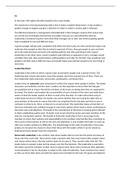P3
In this task I will explain the skills needed to be a team leader.
The importance of having leadership skills is that it helps complete things faster, it also enables a
positive change to happen and give a direction to others in which a chosen path is followed.
The difference between a management and leadership is that managers ensures that various task
are carried out accordingly and that that accessible resources are used efficiently whereas
Leadership is ecentend requires more than what managers do as their role involves getting specific
tasks completed in new and different ways.
A good manager will get tasks completed well within the time scales set, they would also inspire and
motivate other people so that they do what is expected of them, they get people to carry out their
job in the expected ways and work with existing patterns and rules and doing it well. A good
leadership on the other hand, would complete tasks different as opposed to how a manager would
complete their task, they would enhance exiting patterns and rules for the best, they would get new
people to do their jobs in different ways and would inspire and motivate people to do new things in
new ways.
Leadership Styles
Leadership is the action in which a person opts to lead other people over a period of time. The
leadership style chosen determines how other people view them and perceive of them. There are
four leadership styles Autocratic, democratic, participative, and laissez-faire.
Leaders that are autocratic, give instructions in which they expect other people to follow. The leader
has power and authority over the team. Leaders use this expertise to ensure that the task gets
accomplished and to ensure that all the members of the team are doing what they are supposed to
be doing. The leader could explain the accountability of each member of the team and make them
aware of what the leader expects of them as well as the due date. To make instructions easy to
understand and clear to follow, the leader may assess whether they are issuing the right roles to
each member of the team to ensure that tasks are completed by the due date and that no one is
confused on what to do, this is so that errors are prevented. This leadership makes all members of
the team motivated and confident enough to voice their opinion which leads to them contributing to
the teams aims and objectives. This leads to the commitment of the team increasing which will lead
to them establishing quality work. Th leader must ensure that they praise and value members of the
team for voicing their opinion. The benefit of Autocratic leadership is that it encourages team
members to share their opinions and responsibility to the members who feel like they contribute to
the success of the business as well as the aims and objectives. It also enables the leader to come up
with new creative solutions to difficulties. The disadvantage of this style of leadership is that some
people are not given the chance to share their ideas with the leaders which it can be viewed as
bullying and some people may feel uninvolved.
Democratic Leadership is also another style where leaders like to tune into the points and views of
those who they work with. They tend to make a decision after they have heard other people’s ideas
and choose whose idea is the best and the team all act upon it. They consult rather than tell. The
leader listens to people’s ideas but has power over the final decision. This leadership is used when
the leader wants the members of their team to express their ideas and to showcase their aptitudes.
Communication is key for the leader to adapt to this style of leadership. Team members feel valued
as they can share their ideas and will feel valued and committed to the task. The goals and objective
, of the team must be clear and defined for the members of the team to understand and produce
quality work. In this leadership, guidance is offered, by the management and clear instruction is
given. The advantage of this leadership is that members are encouraged to share their sentiments
and gains the respect of employees. The disadvantage is that it is less competent, it delays decision
making and it relies on team being experienced/knowledgeable.
Participative leaders encourage members to contribute to decision making such as suggestions for
new changes and give members an input into decision making although they have power over
finalising decisions. This is usually led by an effective leader. This requires for all the members of the
team to be able to identify significant goals and to develop strategies to achieve aims. The leader will
give the members of the team responsibility by allowing them to develop approaches to attain the
aim of the team. This leadership style is used when trying to bring out the best of each member of
team, when the workload varies, or a new set of ideas to the team which this style of leadership
delivers. The team will have an active participation which will make members of the team feel
motivated and creative. This style of leadership will also increase the opportunity for each member
to expand on their skills and apply the skills that they have which can be shared with the team.
Therefore, this style of leader has an adversely impact on the team as it can waste valuable time as
they need to distinguish strategies. It can also impact the performance of the team negatively if
there is a deadline set for a task. The benefit of this leadership style is that it gives each member the
opening to demonstrate the abilities, members can show their talent and stand out from one
another. However, participative leadership is not time effective and delays decision making.
In Laissez-faire leader’s decision making and the responsibility is left to the members of the team.
The leader allows the group to make the decision. Freedom is available regarding the completion of
tasks and the leader lets members choose their own roles. The advantage of this leadership style is
that it encourages members to make their individual decisions, though decision making team
members can be slow and inconsistent, the leader come be perceived as incapable or disinterested
which can lead to frustration from members of the team towards the leader.
Impact of different Leadership styles
Each style of leadership utilised will influence the performance of the team. The three factors to
consider are the management style of the leader, the situation in which the team Is operating and
the style of leadership the team prefer or are used to.
Autocratic leadership style is ideal to be used when a task requires a clear command structure, in
instance where vital action is needs to be taken and only the leader has knowledge and experience
on what to do which is why this tyle of leadership may be suitable in that case. Whereas a
democratic leadership is suitable for when a team member has a good number of skills, knowledge
and experience on decision making.
Adapting leadership style regarding a situation
Sometimes leaders have to switch their leadership style regarding a situation. It could be the work
environment/ constant ecological changes or the atmosphere in order to manage people effectively.
A good team leader will be able to switch leadership styles impulsively as they have the knowledge
and understanding to do so. Team leaders must also consider the preferred leadership style of team
members, how they would like to be led and the most suitable leadership style for the tasks set.
In terms of identifying my own leadership style I would like to have the ability to control my team. I
would be very happy to discuss things with my team including personal things. As a team leader, you





